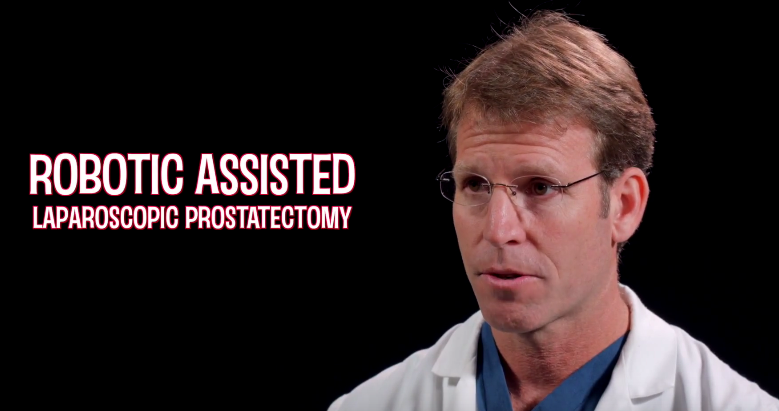Prostate enlargement neither causes nor turns into prostate cancer, and is a completely separate condition. In fact, the risk of prostate cancer is lower in men with an enlarged prostate than in men without the condition. However, the two conditions are linked in various ways. Here are four ways in which BPH and prostate cancer are connected
Continue readingEarly detection of prostate problems
Individualized Treatment for Prostate Cancer – Dr. Rishi Modh
“Prostate cancer has to be an individualized conversation.” says Dr. Rishi Modh of Advanced Urology Institute in St Petersburg, FL.
Continue reading2 Effective Treatment Options for Prostate Cancer
Prostate cancer can be treated and managed in a number of ways. While the preference of the patient is given priority, it should be tempered with the advice of a trained urologist. A urologist can offer advice on what method is appropriate depending on the age of the patient, the patient’s family history and the natural progression of the disease. The patient also needs to be fully advised of the side effects of any form of treatment before agreeing to undergo the treatment. For any given case of prostate cancer, there are always at least two treatment options available.
1. Surgery
A patient with prostate cancer can choose to have the prostate surgically removed to clear the cancer from the body. The procedure is known as Radical Prostatectomy. It is most appropriate in cases where the cancer is localized and has not spread beyond the prostate. However, even when the cancer is localized, a urologist will determine the progression of the disease before recommending surgery. Low risk localized prostate cancer is unlikely to progress and a radical prostatectomy is unnecessary. On the other hand, when the cancer is aggressive and is likely to result in death if untreated, surgery is definitely the most appropriate choice.
Radical prostatectomy is recommended for patients under the age of 75 , or those with a life expectancy of at least ten years. This is because they are more likely to preserve their sexual and urinary functions after the surgery and they have a stronger chance of outliving any side effects the surgery might have.
2. Radiation Therapy
Radiation therapy, or radiotherapy is the use of radiation in high doses to kill malignant cancer cells or slow their development. Unlike radical prostatectomy, it can be used to treat localized prostate cancer and even advanced prostate cancer. It may be applied in combination with other treatment options such as hormone therapy. It may even be applied if a patient undergoes a radical prostatectomy but the procedure fails to eliminate the cancer fully or if the cancer recurs.
Radiation therapy can be administered externally or internally. When done externally, it is referred to as external beam radiation and is very much like having an X-ray. When administered internally, it is referred to as brachytherapy or internal radiation therapy. In this procedure, a radiation implant is placed inside the body near the affected organ. After a while, the implant ceases to produce radiation. The implant, however, remains in the body.
Both radical prostatectomy and radiation therapy are suitable treatment options and choosing between them may seem a little daunting. The professional opinion of a urologist can help by pointing out the finer points of each choice. The patient also may research the subject by reading up on the various options. There are many sites that offer reliable material on this subject.
For more information about treatment options for prostate cancer, visit the “Advanced Urology Institute” website.
Radical Prostatectomy vs Radiation Therapy
Introduction
Radical prostatectomy and radiation therapy are both cancer treatment methods. Radical prostatectomy is specific to prostate cancer and involves the surgical removal of the prostate, either alone or with other surrounding tissues such as the seminal vesicles and some lymph nodes. There are currently various ways in which a radical prostatectomy can be carried out, including robot assisted laparoscopic prostatectomy, open prostatectomy and laparoscopic prostatectomy.
On the other hand, radiation therapy, also known as radiotherapy, is used in the treatment of almost all cancers, including prostate cancer. It involves the use of high doses of radiation to kill cancer cells or to slow their development by destroying their DNA. For radiation therapy to work effectively, it needs to be applied consistently over a period of time.
Choosing between Radical Prostatectomy and Radiation Therapy
The main advantage of radical prostatectomy is that it is arguably a one time procedure. It takes just a few hours to completely remove the affected prostate and the patient is likely to recover fully, albeit gradually and with the monitoring of a urologist. The main disadvantage is that it is appropriate only where the cancer has not spread to other organs outside the prostate. If it has spread, then removing the prostate and leaving behind other affected organs will have no effect at all. In cases where the cancer has spread, radiation therapy may be the more reasonable choice.
Other factors that urologists and surgeons consider before suggesting either procedure include:
1. Age of the patient — Radical prostatectomy is offered mostly to men under 70 years of age because they are more likely to live longer and be able to survive any long term effects of the disease.
2. The natural progression of the disease — Slow progression of a non-aggressive tumor does not lend itself to surgery. This is a case that can be managed by what is called watchful waiting where the disease is monitored constantly but treatment is deferred for a while.
3. The possibility of cure — The goal of radical prostatectomy is to cure the patient of prostate cancer. If for whatever reason it appears that it is unlikely that this objective will be achieved, then radiation therapy or other forms of treatment should be preferred.
Conclusion
It is important to choose the treatment option that works for your body. In order to make the right choice, make a point of consulting a qualified urologist. Reading material on the subject should also be helpful, and sites such as the one operated by the Advanced Urology Institute should be a good place to start.
For more information, visit the Advanced Urology Institute website.
Robotic Assisted Laparoscopic Radical Prostatectomy
Robotic-Assisted Laparoscopic Prostatectomy is a viable option for treating prostate cancer. It is a minimally invasive method for accessing both seminal vesicles and prostate glands during treatment of prostate cancer. Robotic prostatectomy is performed by an experienced surgical team with the help of advanced surgical robotic technology.
What is Robotic-Assisted Radical Prostatectomy?
Robotic prostatectomy involves the use of a laparoscopic system and Robotic Surgery System called da Vinci® Surgical System. This is a sophisticated robotic system designed to enable the surgeons to operate with enhanced vision, precision and control.
With the help of the surgical system, it is possible to pass miniaturized robotic instruments through keyhole incisions and remove the prostate and other nearby tissues with greater accuracy. During a robotic-assisted radical prostatectomy, it is able to create an incision that extends from the belly button to the pubic bone.
In the Robotic-Assisted Laparoscopic Radical-Prostatectomy, an image processing machine and a three-dimensional endoscope are used to achieve a clear and magnified view of structures around the prostate gland. This makes it possible to extract affected parts with optimal preservation of critical body parts such as blood vessels, nerves and muscles.
During the procedure, the surgeon operates the surgical system using a computer console that enables him to control tiny flexible instruments. This makes it possible to achieve higher precision and mobility. The whole process is done without the surgeon’s hand entering the area of the surgery in the patient’s body.
Advantages of Robotic-Assisted Laparoscopic-Radical Prostatectomy:
Robotic prostatectomy has some benefits compared to the traditional open surgical methods. Here are some of the advantages:
- Less pain
- Less loss of blood during the operation
- Shorter stay in the hospital.
Possible risks of Robotic-Assisted Prostatectomy:
The following are possible risks associated with the Robotic Assisted Laparoscopic-Radical Prostatectomy, although they are very unlikely:
- Damage to adjacent tissue or organ
- Infection of surgical site
- Bleeding
Laparoscopic Radical Prostatectomy:
As with all surgical methods, the robotic-assisted radical prostatectomy has a number of potential side effects, which include:
- Urinary incontinence or inability to control urine. However, this problem will reduce over time.
- Erectile dysfunction or impotence: Depending on the age of the patient, erectile function is likely to be affected.
Advanced Urology Institute is a patient-centered institute that works to minimize the possible side effects of a procedure. They research and partner with the best board-certified urologists, among them Dr. David Burday, to make sure that patients have a good experience during the operation and heal well afterward. For further information, visit the “Advanced Urology Institute” website.
Robotic Technology in Urology: Da Vinci Robotic Prostatectomy
Urology has always been one of the leading medical specialties in the adoption and application of the latest cutting-edge technologies. For many decades urology has been one of the areas of medicine that has often readily embraced new technologies and incorporated them into everyday practice for the benefit of patients. Urology was the first medical field to espouse and use scopes for various procedures. And then with the invention of robotic systems, urologists quickly adopted and integrated the da Vinci system in their practices, using it for prostate surgery and making the da Vinci prostatectomy one of the first mainstream
surgical procedures to be performed using robotic technology.
Influence of robotic surgical systems
The introduction of robotic systems in urology has quickly enabled urologists to overcome the limitations of open prostatectomy (traditional laparoscopy) such as limited instrument movement, difficult suturing, complex reconstruction and two-dimensional vision. Likewise, the introduction and quick assimilation of robotic technology has helped to solve the problem of surgeon fatigue in laparoscopic urology. Robotic systems have enabled urologists to perform complex reconstruction and dissection in less than 2 hours delivering excellent outcomes.
Overcoming limitations of open prostatectomy
Before the emergence of robotic surgical systems, men suffering from prostate cancer had very few treatment options. The principal surgical option available was open radical prostatectomy, a procedure that involved large incisions and serious post-operative side effects. For example, when using open prostatectomy, the removal of the entire cancerous prostate resulted in increased risk of post-operative infections, excessive blood loss, considerable pain and longer hospital stays. Open prostatectomy also may lead to loss of sexual function and bladder control due to cutting of the delicate nerve plexus around the prostate. The da Vinci robotic surgery is a minimally invasive procedure that uses smaller incisions, reduces blood loss and ensures a shorter hospital stay, making things better for the patient.
Utmost precision, great outcomes
The intuitive nature of the movement of robotic instruments results in highly precise, accurate, effective and safe prostatectomy. While laparoscopic surgery’s precision is reduced by the fulcrum effect (movement of the instrument tip in the direction opposite to the surgeon’s hands), the da Vinci robotic system has no fulcrum effect, offers three-dimensional visualization, boosts degrees of freedom, eliminates tremor, reduces fatigue and provides motion scaling and ergonomic positioning. Robotic surgery is a remote controlled process in which the surgeon’s movements are precisely translated through sensitive fibers to the instrument’s tip. When applied in prostatectomy, robotic systems have been found to offer several advantages over traditional laparoscopic surgery, including minimal scarring, diminished risk of complications, clinically superior results and quicker recovery.
State-of-the-art prostatectomy at Advanced Urology Institute
Want to be treated by a highly trained and experienced team of surgeons, technicians and nurses? At Advanced Urology Institute, we have urologists who are specialists in robot-assisted surgery for prostate cancer and other urological conditions. We perform dozens of surgical procedures every month using the da Vinci robotic system. This minimally invasive, high-precision robotic technology delivers great results with complex and delicate surgeries such as prostatectomies, where the target site is surrounded and confined by the nerves regulating erectile function and urinary flow. At AUI, we use the robotic system as an exacting tool to avoid damaging these nerves, shorten recovery time and ensure quick return to normal activities.
For more information on exceptional, world-class treatment using robotic technology, visit the “Advanced Urology Institute” site.
Treating Prostate Cancer
Prostate cancer is one of the most common cancers among American men. In fact, it is the most frequently diagnosed non-skin cancer in men, with over 2 million American men currently living with the cancer. Statistically, a new case arises every 3 minutes, one in six American men has prostate cancer, while an American man dies of it every 19 minutes.
Making treatment decisions
At Advanced Urology Institute, we make every effort to deliver world-class treatment and care for patients with prostate cancer. After a diagnosis, our physicians review various treatment options before picking any treatment for the patient. We also conduct further studies, such as biomarker testing and imaging studies, to ensure that we have correctly established the stage or extent of the disease. We use this information to make the right decisions and give prostate cancer patients the most effective treatments. We choose treatment options depending on the cancer itself (high-risk, intermediate risk or low-risk) and patient factors (personal preferences, age and other health issues).
Prostate cancer treatment options
Advanced Urology Institute offers a wide range of innovative and effective diagnostic and treatment procedures for patients with prostate cancer. At the institute, newly diagnosed patients get the opportunity to meet and discuss their condition with renowned and experienced specialists on the same day.
Our treatment options include:
- Active surveillance: For a low-risk prostate cancer that may not harm a patient over the course of his lifetime, urologists at AUI usually recommend close observation. It often comes with secondary chemoprevention.
- Prostatectomy: Prostatectomy is a surgical procedure to remove the prostate. For localized prostate cancer, radical prostatectomy may be employed. However, at Advanced Urology Institute, we commonly apply the robot-assisted technique, which is a minimally-invasive, laparoscopic procedure.
- Radiation: An external beam of radiation is directed at the prostate in order to kill cancerous cells.
- Cryotherapy: Probes are inserted into the prostate gland to allow for the introduction of liquid nitrogen into the gland. Once administered, liquid nitrogen produces an ice ball inside the prostate which destroys cancerous cells.
- Brachytherapy: A radioactive seed is implanted in the prostate. The procedure involves inserting and removing the needles that are used to place radioactive seeds inside the prostate.
- Hormone therapy: Various medications can be administered to reduce or inhibit the secretion of testosterone hormone. Diminished quantities of testosterone means reduced or no growth of the cancer.
- Chemotherapy: Certain drugs may be used to boost the effectiveness of the other treatments, both for metastatic and localized disease.
Multi-disciplinary treatment and care
At Advanced Urology Institute, our goal is to cure prostate cancer while also maximizing the quality of life of our patients. We carefully weigh the benefits of every treatment option against the side effects and develop the most practical individualized treatment programs for all patients. We also believe that effective management of prostate cancer needs extensive collaboration. We have implemented a multidisciplinary approach to treatment that allows our various specialists, such as urologists, radiation oncologists, medical oncologists, radiologists, pathologists and clinical trial nurses to deliberate and get diverse, specialized perspectives before making treatment decisions for any patient. During AUI conferences, detailed discussions among experts help to clarify the benefits and risks of various diagnostic tests and treatment options, resulting in better treatment outcomes for our patients.
Advanced Urology Institute uses image-guided targeting, MRI, ultrasound and fusing 3-D guidance to boost the accuracy and usefulness of prostate biopsies. We also apply minimally-invasive, outpatient procedures in most cases. So, with our comprehensive consultation service and multidisciplinary approach that incorporates the latest technologies, research developments and expertise, all our patients can be sure of the best possible prostate cancer treatment. Want help with prostate cancer? Get more information from our “Advanced Urology Institute” site.
What is Da Vinci Robotic Prostatectomy?
The da Vinci system is a revolutionary, minimally-invasive surgical robot for treating prostate cancer. Designed by Intuitive Surgical to help overcome the shortcomings of both the traditional laparoscopic prostatectomy and open prostatectomy, the da Vinci system enables a surgeon to conduct highly precise, nerve-sparing surgery using several dime-shaped incisions. With the da Vinci surgical procedure, entire cancerous tissue or prostate can be removed, cancer completely eradicated and internal repair achieved without interference with sexual function, potency and bladder control.
Also called robotic prostatectomy, the da Vinci uses a finely-controlled robotic apparatus, including micro-surgical instruments and high-resolution cameras, to perform prostate surgery safely, achieving faster patient recovery and better treatment outcomes.
High-Precision Prostatectomy
During da Vinci robotic surgery, urologists use the “motion scaling” feature on the system to convert subtle hand movements made outside the body into extremely precise and accurate movements inside the body. The urologist controls the robotic arms of the da Vinci console by applying natural wrist and hand movements. Through motion scaling, filtration and seamless translation of hand-and-wrist movements, the urologist can achieve greater precision that is normally not achievable during traditional laparoscopic and open surgery procedures. The da Vinci system not only provides urologists with enhanced dexterity, range of motion and flexibility, but also enables surgeons to safely access difficult-to-operate areas of the pelvis, abdomen and closed chest. The robot also filters and eliminates unpredictable hand movements and hand tremors that may occur during the operation.
Computerized 3-D Visualization
The da Vinci system dramatically improves visualization by providing a sharper and brighter view than can be seen during traditional laparoscopic endoscopes and by the eye during open surgery. The robotic system comes with a proprietary camera, enabling the surgeon to zoom in, rotate and even change image visualization. As a result, the 3-D image produced is clearer and brighter, and with no flickers as seen in traditional laparoscopic systems.
Even though the da Vinci robotic prostatectomy is a remote procedure, urologists have the feeling that their hands are fully immersed in the body and are able to complete all the necessary procedures efficiently. With the 3-D visualization and robotic hand simulation, the da Vinci system enables urologists to perform highly complex procedures more effectively than traditional laparoscopic surgery or open surgery.
Getting da Vinci Prostatectomy at Advanced Urology Institute
At Advanced Urology Institute, the da Vinci prostatectomy patients are usually discharged 24 hours after their operation. The system is used at AUI because it has superior benefits to traditional laparoscopic prostatectomy or open prostate surgery. The benefits of the da Vinci prostate surgery include:
- Reduced pain and higher nerve-sparing rate.
- Shorter hospitalization, with most patients going home the next day.
- Minimal blood loss, fewer transfusions and reduced risk of complications (such as impotence and incontinence).
- Quicker return to pre-surgery erectile function and urinary continence.
- Faster return to routine activities.
Are you looking for a da Vinci urologist near you? You can check out this life-changing technology at Advanced Urology Institute. For more information, visit the “’Advanced Urology Institute” site.
Prostate Cancer: Early Detection and Screening
Prostate cancer screening means conducting tests to find the cancer in people with no symptoms. Screening helps in early detection of the cancer when it is still easier to treat. To detect prostate cancer before symptoms appear, urologists recommend either measuring the amount of prostate-specific antigen (PSA) in blood or doing a digital rectal exam (DRE), when the urologist inserts a gloved, lubricated finger into the rectum. If the results of a PSA or DRE are abnormal, the urologist will request further tests. Finding prostate cancer via a PSA or DRE screening means the disease is probably still at an early stage and will respond well to treatment.
PSA Screening
 The prostate-specific antigen (PSA) test measures the amount of the protein (PSA) released in blood by prostate cells. Even though both normal and cancerous (abnormal) prostate cells produce the protein, higher blood levels of PSA indicate the possibility of cancer. The PSA test is one of the best indicators of prostate cancer and is recommended by urologists because it is widely available, relatively inexpensive and is a low-risk blood test for patients.
The prostate-specific antigen (PSA) test measures the amount of the protein (PSA) released in blood by prostate cells. Even though both normal and cancerous (abnormal) prostate cells produce the protein, higher blood levels of PSA indicate the possibility of cancer. The PSA test is one of the best indicators of prostate cancer and is recommended by urologists because it is widely available, relatively inexpensive and is a low-risk blood test for patients.
Digital Rectal Exam (DRE)
To perform a digital rectal exam, the urologist inserts a gloved and lubricated finger into the rectum in order to feel the state of the prostate gland. Since prostate cancer often begins in the back of the prostate, DRE helps to assess the texture of this area and checks for hard areas and bumps (nodules) which might indicate cancer. DRE is also effective in detecting whether the cancer has spread to nearby tissues or has reoccurred after treatment.
Confirming Prostate Cancer
After a digital rectal exam (DRE) or PSA blood test, the urologist may request a biopsy to confirm the cancer. But before the doctor can decide whether biopsy is necessary, a number of supplementary tests and considerations must be made, including family history, ethnicity, prior biopsy findings and different forms of PSA. A biopsy means the doctor takes out a small portion of the prostate tissue to be examined under a microscope for cancerous cells. Since cancerous cells appear different from normal prostate cells, a close exam of biopsy cells will help to confirm the cancer.
When to Start Screening
The age of beginning or stopping prostate cancer screening depends on individual risk. Men with a higher risk of having prostate cancer should start screening at age 40. This includes African American men and all men with first and second degree relatives with a history of prostate cancer. Men with average risk should start screening at 50, but only after discussing it with their doctors to reduce the rate of unnecessary biopsies. Men age 75 and older or those with limited life expectancy (less than 10 years) should be discouraged from early detection testing for prostate cancer because they may not benefit much from screening. Nevertheless, a decision to go for prostate cancer screening must be made with the help of a urologist or GP and should depend on a man’s lifestyle, family history, overall health and life expectancy. For more information on screening, diagnosis and treatment of prostate cancer, visit the site, Advanced Urology Institute.
Symptoms of Enlarged Prostate
An enlarged prostate, also called benign prostatic hyperplasia (BPH), is an increase in the size of the prostate. While most men have prostate growth throughout their life, not all men get bothersome symptoms. As the prostate grows it presses on the outside of the urethra and can slow down or even stop the flow of urine. BPH is common in men in their 50’s, with about 1 in 3 men above 50 years of age having urinary symptoms.
It is not clear what causes prostate enlargement. However, the following risk factors are involved:
Age – While prostate gland enlargement hardly causes symptoms in men below age 40, about a third of men in their 60’s and about half of men in their 80’s have BPH symptoms.
Hormone Levels – The balance of hormones in the body changes as men grows older, causing the prostate to grow.
Family History – Those with a blood relative, especially a father or brother, with prostate problems are more
likely to have BPH.
Ethnic Background – BPH symptoms are more common in white and black men than Asian men. Black men tend to experience BPH symptoms at a younger age than white men.
Lifestyle – Regular exercise lowers the risk of BPH while obesity increases the risk.
Diabetes and Heart Disease – The risk of BPH increases in men with diabetes, heart disease and those on beta blockers.
What are the symptoms of an enlarged prostate?
The severity of symptoms in people with BPH varies, but tends to worsen over time. Common symptoms include:
- urgent or frequent need to urinate
- nocturia (increased frequency to urinate at night)
- difficulty starting urination
- inability to completely empty the bladder
- weak urine stream or a urine stream that stops and starts
- straining while urinating
- dribbling at the end of urination
The less common symptoms of BPH are:
- inability to urinate
- urinary tract infection
- blood in the urine
You may never get all of these symptoms. In fact, some men with an enlarged prostate do not get any symptoms at all. In some men, the symptoms eventually stabilize and may even improve over time, while in others they may get worse. Some of these symptoms may be caused by other conditions, like anxiety, cold weather, lifestyle factors, certain medicines and other health problems. Therefore, if you have any of the above symptoms, visit your physician to find out what could be causing them.
How can a urologist help?
A urologist will take your medical history and conduct a physical exam. Depending on the severity of the symptoms, the urologist will order tests such as digital rectal exam, urine test, blood test for kidney problems, prostate-specific antigen (PSA) blood test or a neurological exam. The doctor may also request additional tests such as urinary flow test, post-void residual volume test, and 24-hour voiding diary. If the problem is more complex, the urologist may recommend a transrectal ultrasound, prostate biopsy, cystoscopy, urodynamic and pressure flow studies, intravenous pyelogram or CT urogram. If an enlarged prostate is diagnosed, the urologist has various treatment options to offer including lifestyle modifications and medicines. In severe cases, the urologist will opt for surgery. For more information and help with BPH, visit Advanced Urology Institute.
4 Common Symptoms of Enlarged Prostate
Prostate gland enlargement occurs in men as they age and is quite common in men above the age of 50. Medically referred to as benign prostatic hyperplasia (BPH), the condition can be completely benign or have serious complications such as bladder blockage, urinary retention, bladder infections, kidney stones or kidney damage. Since the prostate gland is located underneath the bladder, its increased size can block the flow of urine through the urethra, a tube that carries urine from the bladder out of the body via the penis. This in turn results in problems with urination and other complications.
Benign prostate enlargement (BPH) is not prostate cancer.
Even though the complications of an enlarged prostate may be serious, BPH is not prostate cancer. Neither does it imply you have a greater risk of getting prostate cancer. Usually, the growth of prostate tissue associated with BPH starts around the inner prostate (a ring of tissue around the urethra) and progresses inward. In contrast to this, prostate cancer often grows from the outer part of the prostate and continues outward. Therefore, having an enlarged prostate does not increase your risk of prostate cancer because the two conditions typically begin in different areas of the prostate. Nevertheless, men can have prostate cancer and enlarged prostate at the same time, so you should speak with your urologist or GP if you have any concerns about prostate cancer. Keep in mind that BPH does not cause erection problems and does not affect a man’s capacity to father children.
What causes BPH?
Generally, an enlarged prostate is considered a normal part of the aging process in men, believed to result from changes in hormone levels and cell growth. And while the actual cause of benign prostate enlargement is still unknown, studies have shown that changes in the cells of the testicles play a role in the growth of the gland. This is confirmed by the fact that men whose testicles are removed at a young age never develop the condition while those whose testicles are removed after developing BPH experience shrinkage in the size of the prostate. Some studies have also revealed that men with obesity or diabetes, as well as men with a father or brother with the condition, are more likely to develop BPH.
What are the 4 common symptoms of an enlarged prostate?
One of the more common symptoms of BPH is a frequent or urgent need to urinate. Men with BPH will have the urge to urinate more often and particularly at night, a condition known as nocturia. By frequent urination, we mean having to pass urine eight or more times a day. The need to urinate will be urgent because the increased pressure placed on the bladder and urethra by the enlarged prostate make holding urine more difficult.
On the other hand, urinating can be made more difficult by BPH because the increased pressure on the urethra may block urine flow from the bladder out through the penis. You may find it hard to start a urine stream or experience an interrupted or weak urine stream. Depending on the severity of your BPH, you may find it difficult to pass urine, a condition resulting in urine retention. When this happens, you must see your doctor immediately so that a catheter can be inserted into your bladder to drain the urine. Your doctor may recommend you see a urologist for surgery to remove a portion of the enlarged prostate tissue or make cuts on the prostate in order to widen the urethra.
Another symptom is pain during urination or ejaculation caused by pressure on the urinary tract or reproductive system due to BPH. In fact, some men even feel the need to push out urine, which may also cause pain. Remember, pain during ejaculation or urination may also be due to infection.
Other problems associated with an enlarged prostate include urinary tract infections, unusual urine color or smell, blood in urine, bladder stones, and bladder or kidney damage. But not all men with BPH show these symptoms. In fact, some men with enlarged prostate do not get any symptoms at all. If you do have symptoms, you should definitely see your doctor.
How is an enlarged prostate treated?
Your urologist will ask you questions about your symptoms and about your past health. A physical exam, a urine test (urinalysis) and a digital rectal examination will also be performed to aid diagnosis. In some cases, your doctor will request the prostate-specific antigen (PSA) test in order to rule out prostate cancer.
If you only have mild to moderate symptoms, your doctor can recommend “watchful waiting” for lifestyle changes and regular check-ups to monitor symptoms. Your doctor may also prescribe medications such as alpha-blockers or 5-alpha-reductase inhibitors to alleviate the symptoms.
If your condition does not improve after trying recommended lifestyle changes and medications, your doctor may opt for surgery. The type of surgery chosen by the urologist will depend on the size of your prostate, any other medical problems you have and the potential risks and benefits of the operation. For more information about treatments for enlarged prostate, visit an Advanced Urology Institute clinic near you.
What is Cancer of the Prostate? with Dr Denis Healey
Video: What is Cancer of the Prostate? with Dr Denis Healey
The prostate gland is a part of the male reproductive system that secretes seminal fluid, a milky substance that combines with sperm produced in the testicles to form semen. Contact a urologist now to get treatment as soon as possible. [Read Full Article…]
The PSA Test, The Best Tool for Prostate Cancer Screening – Dr Matthew Merrell
Video: The PSA Test, The Best Tool for Prostate Cancer Screening – Dr Matthew Merrell
PSA exam is a blood test to determine the levels of prostate specific antigens. The tests measure the level of PSA in your body, which is then compared to the expected amount for your age. Contact a urologist now to know more about this procedure. [Read Full Article…]
Robotic Assisted Laparoscopic Prostatectomy, Surgical Advancement in Urology – Dr Matthew Merrell
Video: Robotic Assisted Laparoscopic Prostatectomy, Surgical Advancement in Urology – Dr Matthew Merrell
Robotic Assisted Laparoscopic Prostatectomy allows the surgeon greater visualization, enhanced dexterity, precision, control and superior ergonomics.[Read Full Article…]












